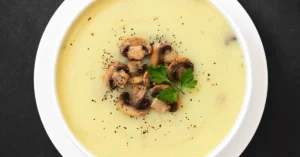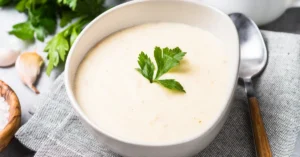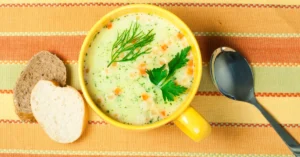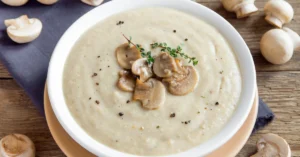Reducing sodium intake is crucial for maintaining heart health and managing blood pressure. For many, store-bought soups contain excessive salt, making homemade alternatives a better choice. Low sodium cream of chicken soup is not only healthier but also full of flavor when prepared right. In this article, we’ll guide you through creating a delicious, heart-healthy version of this comforting classic. Read on to discover the benefits and a simple recipe that’s easy to customize to your taste!

Introduction to Low Sodium Diets
A low sodium diet focuses on limiting the amount of sodium you consume, primarily to improve cardiovascular health and reduce the risk of high blood pressure, stroke, and heart disease. Sodium, often found in salt, is essential for bodily functions but is commonly consumed in excess, especially through processed foods, snacks, and canned soups.
When it comes to soup, many store-bought versions, including cream of chicken, are loaded with sodium as a preservative and flavor enhancer. For individuals aiming to reduce their sodium intake, this poses a challenge. High sodium consumption can lead to water retention, increased blood pressure, and long-term health issues.
By choosing homemade low sodium options, like this cream of chicken soup, you can control how much sodium is added without sacrificing taste. Fresh ingredients, flavorful herbs, and spices can naturally enhance the dish, providing a satisfying and healthy alternative to the high-sodium varieties available in stores.

Why Choose Low Sodium Cream of Chicken Soup?
Store-bought cream of chicken soups are notoriously high in sodium, often containing over 800 milligrams per serving. This high sodium content can quickly add up, especially if you’re using these soups in casseroles, sauces, or as a stand-alone meal. Consuming too much sodium can increase the risk of hypertension, heart disease, and stroke. For those managing their sodium intake, finding a low-sodium alternative is key.
Making your own low sodium cream of chicken soup offers several advantages:
Control Over Ingredients:
When you prepare the soup at home, you have full control over what goes into it. You can use fresh, low sodium chicken broth, minimal added salt, and healthier thickening agents. By doing so, you avoid unnecessary preservatives and flavor enhancers found in canned varieties.
Healthier Flavor:
Low sodium doesn’t mean bland. In fact, it opens the door to experimenting with other ingredients to boost flavor naturally. Fresh herbs, garlic, and a variety of vegetables can bring out the savory taste without relying on sodium. Using roasted or poached chicken adds depth to the dish, making it as flavorful as the traditional version.
Supports Heart Health:
Consuming less sodium helps lower blood pressure and reduces strain on the cardiovascular system. This homemade version aligns with heart-healthy eating, benefiting individuals managing conditions such as hypertension or kidney disease.
Cost-Effective:
While store-bought options may seem convenient, they often come at a higher price for lower quality. By making your own low sodium cream of chicken soup, you can save money by using basic, affordable ingredients and preparing larger batches that can be stored for future meals.
Customization:
One of the best parts about making soup at home is that you can adjust the recipe to your liking. You can add more vegetables, use dairy-free options, or even increase the protein content. Plus, you can adjust the thickness of the soup by playing with different ingredients like potatoes, cornstarch, or cream substitutes.

Essential Ingredients for Low Sodium Cream of Chicken Soup
Making a flavorful low sodium cream of chicken soup requires using fresh ingredients and thoughtful substitutes to replace high-sodium components. Here are the essential ingredients and tips for crafting a delicious, heart-healthy version:
Low-Sodium Chicken Broth
- Why It’s Important: Chicken broth forms the base of the soup, but traditional store-bought versions can be loaded with sodium. Opt for low-sodium or no-sodium-added broth to significantly reduce the salt content without sacrificing the savory chicken flavor.
- Tip: If possible, make your own homemade chicken broth using chicken bones, vegetables, and herbs. This gives you full control over the sodium content while delivering a richer flavor.
Fresh, Cooked Chicken
- Why It’s Important: Freshly cooked chicken breast or thighs offer better flavor and texture compared to canned or pre-seasoned chicken, which often contains added sodium.
- Tip: Poach or roast chicken with herbs, garlic, and a little olive oil to keep it moist and enhance its natural taste.
Aromatics (Onions, Garlic, Celery, Carrots)
- Why They’re Important: Aromatics form the flavor base for any good soup. Onions, garlic, celery, and carrots add depth and natural sweetness without needing salt.
- Tip: Sauté these aromatics in a small amount of unsalted butter or olive oil to build rich, savory layers of flavor at the start of your recipe.
Herbs and Spices
- Why They’re Important: Herbs and spices can elevate the flavor of your soup, compensating for the lack of salt. Thyme, parsley, bay leaves, rosemary, and a pinch of black pepper work well with chicken.
- Tip: Fresh herbs pack more punch than dried ones. However, if using dried, add them early in the cooking process to allow time for the flavors to release. Add fresh herbs near the end for a bright, fresh finish.
Milk or Cream Alternatives
- Why It’s Important: Traditional cream of chicken soup uses heavy cream, which can be high in fat and calories. For a lighter and healthier option, you can use low-fat milk, unsweetened almond milk, or even evaporated milk.
- Tip: For extra creaminess without added fat, try blending a portion of the soup with cooked potatoes or cauliflower. This adds a smooth texture while keeping it low in calories and sodium.
Flour or Cornstarch for Thickening
- Why It’s Important: Flour or cornstarch acts as a thickening agent for your soup, giving it that rich, creamy consistency. In traditional recipes, a roux (a mixture of butter and flour) is often used, but you can use healthier alternatives.
- Tip: Instead of using a butter-heavy roux, whisk the flour or cornstarch into low-fat milk or broth, then slowly incorporate it into the soup to thicken without adding extra sodium or fat.
Unsalted Butter or Olive Oil
- Why It’s Important: A small amount of fat, like unsalted butter or olive oil, is necessary for sautéing vegetables and giving the soup a smooth mouthfeel. Using unsalted options helps maintain low sodium levels.
- Tip: Olive oil adds a subtle flavor and healthy fats, making it a great substitute for butter in this recipe. If you prefer the richness of butter, opt for unsalted and use it sparingly.
Potatoes or Cauliflower (Optional)
- Why They’re Important: Potatoes or cauliflower can be added to give your soup a thicker, creamier texture without the need for additional fat or sodium.
- Tip: Blend boiled potatoes or cauliflower with some of the soup to create a naturally creamy consistency that mimics the texture of heavy cream.
Low-Sodium Seasonings
- Why They’re Important: To further enhance the flavor, consider using low-sodium seasoning blends or ingredients like lemon juice, balsamic vinegar, or nutritional yeast. These add a punch of flavor without the need for extra salt.
- Tip: A splash of acid, like lemon juice or vinegar, can brighten up the flavors, making them pop even in low-sodium dishes.

Step-by-Step Recipe for Low Sodium Cream of Chicken Soup
Creating a low sodium cream of chicken soup at home is easier than you might think. By following this step-by-step recipe, you’ll have a delicious, healthier version of a classic comfort food in no time. Here’s how to make it:
Ingredients:
- 2 cups low sodium chicken broth (homemade or store-bought)
- 1 ½ cups cooked chicken (shredded or diced, preferably skinless)
- 1 medium onion, finely chopped
- 2 cloves garlic, minced
- 2 stalks celery, finely chopped
- 1 large carrot, diced
- 2 tablespoons unsalted butter or olive oil
- 3 tablespoons all-purpose flour (or cornstarch for gluten-free)
- 1 cup low-fat milk (or unsweetened almond milk for dairy-free)
- ½ teaspoon dried thyme or 1 teaspoon fresh thyme
- 1 bay leaf
- ¼ teaspoon black pepper (adjust to taste)
- 1 tablespoon chopped fresh parsley (optional for garnish)
- Lemon juice (optional for a hint of acidity)
Instructions:
Step 1: Sauté the Aromatics
Heat the unsalted butter or olive oil in a large pot over medium heat. Add the finely chopped onion, garlic, celery, and carrots to the pot. Sauté for 5-7 minutes until the vegetables are softened and fragrant, but not browned.
Tip: Stir frequently to avoid burning the garlic and ensure even cooking of the vegetables.
Step 2: Add the Flour to Thicken
Once the vegetables are tender, sprinkle the flour over them. Stir well to coat the vegetables in the flour, allowing it to cook for about 1-2 minutes. This will remove the raw flour taste and help thicken the soup later.
Note: If using cornstarch as a thickener, skip this step and mix cornstarch with cold milk or broth in Step 4.
Step 3: Add the Broth and Herbs
Gradually pour in the low sodium chicken broth while stirring to prevent lumps from forming. Stir continuously until the mixture starts to thicken slightly. Add the dried thyme (or fresh thyme) and the bay leaf to the pot. Bring the mixture to a gentle simmer, stirring occasionally. Let it cook for about 10-15 minutes to allow the flavors to meld together.
Step 4: Stir in the Milk for Creaminess
Slowly pour in the low-fat milk (or your milk substitute) while stirring the soup to ensure it blends smoothly. Let the soup simmer for another 5 minutes until it becomes creamy and well-combined.
Tip: If using cornstarch, now is the time to whisk a slurry (1 tablespoon cornstarch mixed with 2 tablespoons cold water or milk) into the soup to thicken it.
Step 5: Add the Cooked Chicken
Stir in the shredded or diced cooked chicken, making sure it’s evenly distributed in the soup. Continue to simmer for an additional 5-10 minutes until the chicken is heated through and the soup reaches your desired consistency.
Step 6: Season and Finish
Season the soup with black pepper to taste. Remember, we’re keeping the sodium low, so refrain from adding extra salt.
Optional: Add a squeeze of lemon juice at the end for a bright, fresh flavor. This helps to bring out the other flavors without needing salt. Remove the bay leaf and discard it.
Step 7: Garnish and Serve
- Ladle the soup into bowls and garnish with freshly chopped parsley for a pop of color and added freshness.
- Serve the soup hot with a side of whole grain bread or a salad for a complete, heart-healthy meal.
Cooking Tips:
- Adjust the Thickness: If the soup is too thick, you can add more low sodium chicken broth or milk to thin it out. If it’s too thin, let it simmer uncovered a bit longer to reduce and thicken.
- Blended Option: For a creamier texture, you can blend a portion of the soup with an immersion blender before adding the chicken, then stir everything back together. This adds body without the need for additional cream.
Total Time:
30-40 minutes
Servings: 4-6 bowls
This low sodium cream of chicken soup is the perfect way to enjoy a comforting, creamy dish without the added salt. By using fresh ingredients and simple techniques, you can create a healthier alternative to store-bought versions while still delivering all the flavors you love. Enjoy it as a stand-alone meal or as part of a larger meal—either way, it’s a satisfying and nutritious choice.

Customization Tips for the Recipe
One of the best parts about making your own low sodium cream of chicken soup is the ability to tailor it to your personal preferences or dietary needs. Here are some easy ways to customize the recipe to suit your taste, nutrition goals, or desired consistency:
Add More Vegetables
Why Customize?
Adding more vegetables not only enhances the nutritional value of your soup but also adds different flavors and textures, keeping the dish interesting and hearty.
Options to Try:
- Mushrooms: Sliced mushrooms add a rich, umami flavor and a meaty texture, perfect for adding depth to your soup.
- Peas or Green Beans: These vegetables bring a slight sweetness and vibrant color to the dish, while also boosting fiber content.
- Spinach or Kale: Stir in some fresh spinach or kale at the end of cooking for added vitamins and minerals without affecting the soup’s creaminess.
- Zucchini or Bell Peppers: Diced zucchini or bell peppers add crunch and a mild flavor that pairs well with chicken and cream-based soups.
Change the Protein
Why Customize?
You can vary the soup by using different proteins, which can make the dish more versatile and meet different dietary needs.
Options to Try:
- Turkey: Use cooked turkey breast instead of chicken for a seasonal twist, especially around the holidays.
- Tofu: For a vegetarian or vegan version, use firm tofu as a protein substitute. Cube or crumble it, and sauté before adding to the soup.
- Legumes: Chickpeas, white beans, or lentils can be great low-sodium, plant-based options to replace or complement chicken while adding extra fiber and protein.
Dairy-Free or Vegan Options
Why Customize?
Whether you’re lactose intolerant, vegan, or simply looking for a lighter option, there are easy dairy-free alternatives that won’t compromise the soup’s creamy texture.
Options to Try:
- Almond or Oat Milk: These plant-based milk options provide creaminess without the fat or lactose found in dairy. Make sure to choose unsweetened versions to avoid adding unwanted sugar to the soup.
- Coconut Milk: For a richer, slightly tropical flavor, try using light coconut milk. It thickens well and adds a unique twist to the traditional recipe.
- Cashew Cream: Blend soaked cashews with water to create a velvety, dairy-free cream that’s perfect for thickening the soup while adding healthy fats.
Adjust the Creaminess
Why Customize?
Depending on your preference for a lighter or thicker soup, you can easily adjust the texture to match what you enjoy.
Options to Try:
- For a Thicker Soup: If you prefer a rich, thick soup, you can add extra flour or cornstarch. Alternatively, blending some of the cooked vegetables like potatoes or cauliflower into the soup can naturally thicken it.
- For a Lighter Soup: If you want a lighter soup, reduce the amount of milk or cream, or opt for more broth in place of some of the dairy. This creates a more broth-like texture without sacrificing flavor.
Enhance the Flavor with Low Sodium Seasonings
Why Customize?
Without relying on salt, you can still create a bold, flavorful soup by incorporating a variety of herbs, spices, and acidic elements.
Options to Try:
- Herb Mixes: Use a blend of Italian herbs like oregano, basil, and rosemary for a Mediterranean flavor. Or try dill and tarragon for a more subtle, herbal taste.
- Smoked Paprika or Cayenne: These spices add warmth and a hint of smokiness or heat to your soup without adding salt.
- Lemon Juice or Vinegar: Adding a touch of acidity at the end of cooking, such as lemon juice, apple cider vinegar, or balsamic vinegar, brightens the flavors of the soup. It’s a great way to boost taste without reaching for the salt shaker.
Incorporate Whole Grains or Pasta
Why Customize?
For a heartier, more filling soup, consider adding whole grains or pasta to the recipe. This adds texture and turns the soup into a more substantial meal.
Options to Try:
- Brown Rice: Add cooked brown rice for a fiber-rich grain that pairs well with chicken and cream-based soups. It also helps absorb the broth, giving the soup a thicker, more satisfying texture.
- Barley or Quinoa: These grains are nutrient-dense and give the soup a chewy, nutty quality that enhances both flavor and texture.
- Pasta: Small pasta shapes like orzo, ditalini, or whole wheat elbow pasta can make the soup more filling. Just make sure to use low-sodium or homemade broth to keep the sodium levels in check.
Spice it Up with Heat
Why Customize?
If you love spicy foods, adding heat to the soup can create an exciting flavor contrast with the creamy base.
Options to Try:
- Red Pepper Flakes or Hot Sauce: Sprinkle in a little red pepper flakes or add a dash of your favorite low-sodium hot sauce to give the soup a kick without overpowering the other flavors.
- Jalapeños or Serrano Peppers: For a fresh source of heat, finely dice some jalapeños or serrano peppers and sauté them with the onions and garlic at the start of the recipe.
Switch Up the Broth
Why Customize?
While low sodium chicken broth is a staple in this recipe, you can experiment with other broths to change the flavor profile or meet dietary needs.
Options to Try:
- Vegetable Broth: For a vegetarian or lighter version, use low-sodium vegetable broth. It still provides a rich base while cutting down on animal-based ingredients.
- Bone Broth: If you’re looking for extra nutrients, bone broth offers added protein and collagen while maintaining a deep, savory flavor.
Add a Topping
Why Customize?
A good topping can take your soup to the next level by adding texture and an extra burst of flavor.
Options to Try:
- Croutons: For a crunchy contrast, top the soup with homemade low-sodium croutons. Toast whole grain bread cubes with olive oil and your favorite seasonings for a delicious finish.
- Grated Parmesan: A small sprinkle of freshly grated Parmesan (opt for a low-sodium variety if possible) can enhance the savory flavors without adding too much salt.
- Chopped Fresh Herbs: Brighten the soup with a finishing touch of fresh parsley, cilantro, or chives. These herbs add a pop of color and freshness to each bowl.

Health Benefits of Low Sodium Cream of Chicken Soup
Opting for a low sodium cream of chicken soup offers several health benefits that contribute to overall well-being. Here’s a closer look at how this comforting dish can positively impact your health:
Supports Heart Health
- Why It Matters: High sodium intake is linked to hypertension (high blood pressure), which is a major risk factor for heart disease and stroke. By reducing sodium in your diet, you can lower your blood pressure and decrease your risk of cardiovascular issues.
- Health Benefit: Low sodium cream of chicken soup helps maintain healthy blood pressure levels, promoting heart health and reducing the risk of developing heart-related conditions.
Aids in Weight Management
- Why It Matters: Many high-sodium foods are also high in calories, leading to weight gain and associated health issues. Lowering sodium often correlates with consuming whole, nutritious foods, which can support a healthy weight.
- Health Benefit: The ingredients in low sodium cream of chicken soup—like vegetables, lean protein, and whole grains—are nutrient-dense yet lower in calories, making it a satisfying choice for weight management. The fiber from vegetables and grains also promotes satiety, helping control hunger.
Enhances Nutrient Intake
- Why It Matters: Homemade soups often incorporate a variety of vegetables, lean proteins, and healthy fats. This variety increases the overall nutrient profile of the dish compared to processed alternatives.
- Health Benefit: By using fresh, nutrient-rich ingredients in your low sodium cream of chicken soup, you increase your intake of essential vitamins and minerals. Ingredients like carrots, celery, and chicken provide vitamins A, C, B6, and minerals such as potassium and magnesium, which are vital for overall health.
Improves Hydration
- Why It Matters: Sodium can cause the body to retain water, leading to bloating and discomfort. Reducing sodium intake can help promote better fluid balance and hydration.
- Health Benefit: Low sodium cream of chicken soup, made primarily with water-based ingredients like broth and vegetables, can contribute to daily hydration needs. Staying well-hydrated is crucial for digestion, skin health, and overall bodily functions.
Promotes Digestive Health
- Why It Matters: A diet high in sodium can lead to gastrointestinal discomfort and contribute to issues like bloating and constipation. Incorporating more fiber-rich foods helps promote digestive regularity.
- Health Benefit: The vegetables and whole grains in low sodium cream of chicken soup provide dietary fiber, which aids digestion, promotes regular bowel movements, and supports gut health. Fiber also helps control blood sugar levels, contributing to stable energy levels.
Boosts Immune Function
- Why It Matters: A healthy diet is essential for a well-functioning immune system. Ingredients like garlic and certain vegetables contain antioxidants and compounds that support immune health.
- Health Benefit: Homemade low sodium cream of chicken soup often includes ingredients known for their immune-boosting properties. Garlic, for instance, is recognized for its antimicrobial effects, while vegetables provide essential vitamins and antioxidants that help fight off illness.
Customizable for Dietary Needs
- Why It Matters: Many individuals have specific dietary needs or restrictions, whether due to health conditions, allergies, or personal preferences. A low sodium cream of chicken soup can be easily adjusted to meet these needs.
- Health Benefit: By customizing your soup with gluten-free grains, dairy alternatives, or additional vegetables, you can create a dish that fits various dietary lifestyles while maintaining its nutritional value. This adaptability ensures that more people can enjoy the soup without compromising their health goals.
Comfort Food Without the Guilt
- Why It Matters: Many traditional comfort foods can be high in calories, fat, and sodium, making them less enjoyable for health-conscious individuals. Comfort foods should still be satisfying without the guilt of unhealthy ingredients.
- Health Benefit: Low sodium cream of chicken soup offers the familiar warmth and satisfaction of comfort food while keeping health in focus. Enjoying a hearty bowl of soup can provide emotional comfort and satisfaction, helping to alleviate stress and promote well-being.

Storage and Reheating Tips for Low Sodium Cream of Chicken Soup
Proper storage and reheating are essential to maintain the quality, flavor, and safety of your low sodium cream of chicken soup. Here’s how to store it effectively and reheat it without compromising its taste or texture:
Cooling the Soup
Why It Matters:
Rapid cooling prevents bacterial growth, ensuring food safety. It’s important to cool the soup to room temperature before storing it.
How to Do It:
- After cooking, allow the soup to cool on the countertop for no more than two hours.
- Stir occasionally to help the soup cool evenly and quickly. You can also place the pot in an ice bath or divide the soup into smaller containers to speed up the cooling process.
Storing in the Refrigerator
Why It Matters:
Proper refrigeration keeps the soup safe to eat while maintaining its flavor and texture.
How to Do It:
- Transfer the cooled soup into airtight containers. Use glass or BPA-free plastic containers for best results.
- Leave some space at the top of the container, as liquids expand when frozen.
- Label the containers with the date to keep track of freshness.
Freezing for Longer Storage
Why It Matters:
Freezing allows you to keep your low sodium cream of chicken soup for an extended period without sacrificing quality.
How to Do It:
- For long-term storage, place the cooled soup in freezer-safe containers or heavy-duty freezer bags.
- Remove as much air as possible from freezer bags before sealing to prevent freezer burn.
- Soup can typically be frozen for up to three months without losing its quality. Label the bags or containers with the date for easy identification.
Thawing the Soup
Why It Matters:
Proper thawing ensures the soup retains its texture and flavor. Avoid thawing at room temperature to prevent bacterial growth.
How to Do It:
- For best results, transfer the soup from the freezer to the refrigerator and let it thaw overnight.
- If you need to thaw it quickly, place the sealed bag or container in a bowl of cold water for a couple of hours. Change the water every 30 minutes to ensure it stays cold.
- You can also reheat directly from frozen, but be prepared to add extra time for warming.
Reheating on the Stovetop
Why It Matters:
Reheating on the stovetop allows for even heating and better control over the temperature, ensuring the soup is heated thoroughly without overcooking.
How to Do It:
- Pour the thawed or refrigerated soup into a saucepan.
- Heat over medium-low heat, stirring frequently to prevent sticking and burning.
- Add a splash of low sodium chicken broth or milk if the soup is too thick. Continue to heat until it reaches a gentle simmer.
- Ensure the soup is heated to at least 165°F (74°C) to ensure safety.
Reheating in the Microwave
Why It Matters:
Microwaving is a quick and convenient way to reheat individual portions of soup.
How to Do It:
- Transfer a serving of soup into a microwave-safe bowl. Leave space at the top to prevent overflow.
- Cover the bowl with a microwave-safe lid or plate to retain moisture and prevent splatters.
- Heat on high in one-minute increments, stirring between each interval until the soup is steaming hot.
- Again, make sure it reaches 165°F (74°C) for safe consumption.
Serving After Reheating
Why It Matters:
Properly reheated soup tastes better and maintains its appealing texture.
How to Do It:
- Taste the soup after reheating and adjust the seasoning if needed, considering it may need a touch more flavor after freezing and thawing.
- Serve hot, garnished with fresh herbs or croutons for added flavor and texture.
Safety Considerations
Why It Matters:
Food safety is paramount when storing and reheating soup to avoid foodborne illnesses.
Key Points:
- Do not leave the soup out at room temperature for more than two hours to prevent bacterial growth.
- Once reheated, consume the soup within 3-4 days if kept in the refrigerator. If you notice any off smells or changes in texture, discard it.

Recipe Variations for Low Sodium Cream of Chicken Soup
Exploring variations of low sodium cream of chicken soup can keep your meals exciting and cater to different taste preferences or dietary needs. Here are some creative twists and adaptations you can try:
Low Sodium Cream of Mushroom Soup
Why It’s Great:
For mushroom lovers, this variation captures the rich, earthy flavors of mushrooms while retaining the creamy texture of the original recipe.
How to Make It:
- Substitute half or all of the chicken with sliced mushrooms (like cremini or shiitake).
- Sauté the mushrooms with onions and garlic before adding the broth and other ingredients.
- For added creaminess, consider blending a portion of the cooked mushrooms into a puree before returning it to the pot.
Vegetable Cream Soup
Why It’s Great:
A vegetable version of the soup is perfect for those seeking a plant-based option while still enjoying a creamy texture.
How to Make It:
- Replace chicken with a variety of vegetables like broccoli, cauliflower, carrots, and peas.
- Use vegetable broth instead of chicken broth to enhance the vegetable flavors.
- Consider adding pureed white beans for creaminess and protein, making the soup both filling and nutritious.
Chicken and Wild Rice Soup
Why It’s Great:
This hearty variation adds wild rice for a chewy texture and nutty flavor, making it a satisfying meal on its own.
How to Make It:
- Cook wild rice separately according to package instructions.
- Incorporate cooked wild rice into the original low sodium cream of chicken soup during the last few minutes of cooking.
- Adjust the liquid as necessary to achieve your desired soup consistency.
Spicy Southwest Chicken Soup
Why It’s Great:
Adding southwestern flavors can give your soup a kick, perfect for those who enjoy a little heat.
How to Make It:
- Add diced jalapeños or green chilies when sautéing onions and garlic.
- Incorporate spices like cumin, paprika, and cayenne pepper to enhance the flavor profile.
- Top with fresh cilantro and a squeeze of lime juice before serving for added brightness.
Creamy Coconut Chicken Soup
Why It’s Great:
A touch of coconut milk creates a tropical twist, perfect for warm weather or a comforting bowl any time of year.
How to Make It:
- Replace some of the chicken broth with light coconut milk for a creamy, rich texture.
- Add lime zest and juice to complement the coconut flavor.
- Incorporate fresh veggies like bell peppers and snap peas for crunch and freshness.
Asian-Inspired Chicken Soup
Why It’s Great:
Infusing the soup with Asian flavors can create a unique and aromatic dish that’s both comforting and refreshing.
How to Make It:
- Use low sodium chicken broth and add ingredients like ginger, soy sauce (or tamari for gluten-free), and sesame oil.
- Incorporate bok choy, mushrooms, and green onions for a colorful and nutritious mix.
- Garnish with chopped cilantro and a sprinkle of sesame seeds before serving.
Creamy Pesto Chicken Soup
Why It’s Great:
Pesto adds a burst of flavor and color, transforming your soup into a delightful culinary experience.
How to Make It:
- Stir in a few tablespoons of homemade or store-bought low sodium pesto during the last few minutes of cooking.
- Consider adding spinach or kale for an extra nutrient boost and vibrant color.
- Serve with crusty whole-grain bread for a complete meal.
Herbed Lemon Chicken Soup
Why It’s Great:
This refreshing version incorporates bright lemon flavors, making it perfect for spring or summer dining.
How to Make It:
- Add fresh lemon juice and zest for a citrusy kick just before serving.
- Incorporate fresh herbs like dill, parsley, or thyme to enhance the flavor.
- Consider adding orzo or a small pasta to make it more filling.
Curried Chicken Soup
Why It’s Great:
A curry-inspired soup introduces warmth and a unique flavor profile, ideal for those who enjoy exotic spices.
How to Make It:
- Sauté onions and garlic with curry powder before adding broth and other ingredients.
- Optionally, add diced potatoes or sweet potatoes for a heartier texture.
- Stir in coconut milk for creaminess and to balance the spices.
Slow Cooker Cream of Chicken Soup
Why It’s Great:
This variation allows for hands-off cooking, making it easy to prepare a nutritious meal even on busy days.
How to Make It:
- Combine all ingredients (chicken, vegetables, broth, and spices) in a slow cooker.
- Cook on low for 6-8 hours or high for 3-4 hours, until the chicken is cooked through.
- About 30 minutes before serving, stir in the milk or cream and let it heat through.

Conclusion
In conclusion, low sodium cream of chicken soup is a nourishing and versatile dish that fits seamlessly into a health-conscious lifestyle. Its adaptability allows for endless variations, catering to different tastes and dietary needs while delivering essential nutrients without excess sodium. Whether you’re enjoying it as a comforting bowl on a chilly day or incorporating it into meal prep for the week, this soup proves to be both satisfying and beneficial. Embracing this recipe not only enhances your culinary repertoire but also supports your health goals, making it a wonderful addition to your regular meals. So, gather your ingredients and indulge in a wholesome, homemade soup that warms both the heart and the body!
[WPSM_AC id=1578]
Low Sodium Cream Of Chicken Soup

Save multiple hundreds of your sodium budget with this simple Low Sodium Cream of Chicken soup. Which also serves as a essential base for numerous other recipes.
- 6 Tbsp butter no salt added
- 9 Tbsp all purpose flour
- 1 1/2 cups chicken stock no salt added
- 1 1/2 cup 2% milk (I used 2%)
- 1 tsp Mrs. Dash Original Table Blend seasoning no salt
- 1-2 tsp Herb Ox chicken bouillon no sodium
- 1 1/2 tsp garlic powder
- 1 tsp freshly-ground black pepper
- 1/2 tsp onion powder
- 1/2 tsp celery seed (optional)
- In a medium sauce pan, melt butter over medium heat.
- Add flour to the pan, and whisk together to making a roux (about 2 minutes) it should turn lightly brown.
- Add the chicken broth and milk, and whisk together till lumps are gone.
- Stir in garlic powder, onion powder, celery seed, pepper, Mrs. Dash Table Blend, Herb Ox chicken bouillon sodium free
- Bring to a simmer and continue cooking and slow stir until mixture thickens, about 2 to 3 minutes.
- Remove from heat and use as base for another recipe, a soup, or store after cooled.
